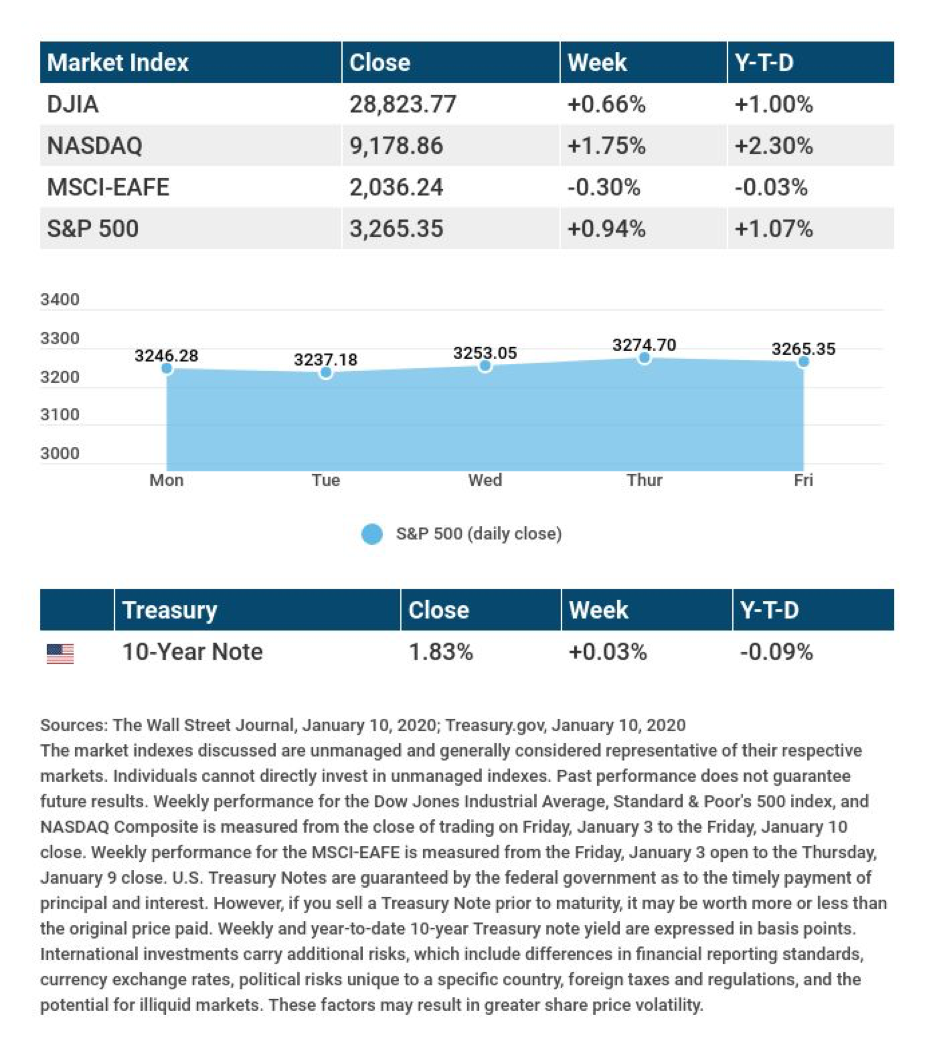The Week on Wall Street
The market had a choppy five days, with traders reacting to geopolitical developments and weaker-than-expected jobs data. Even so, the three major U.S. equity indices posted weekly gains and continued their strong start to the new year. During Friday’s trading session, the Dow Jones Industrial Average topped 29,000 for the first time.
Rising 1.75% for the week, the Nasdaq Composite outgained both the Dow (up 0.66%) and the S&P 500 (up 0.94%). The story for foreign stocks was different: the MSCI EAFE index declined 0.30%.[1][2]
Holiday Hiring Numbers
Wall Street was unimpressed by the latest jobs report from the Department of Labor. Employers added 145,000 net new workers in December; economists surveyed by Dow Jones had forecast a gain of 160,000. Wages grew less than 3% year-over-year for the first time in 17 months.
Unemployment remained at a 50-year low of 3.5%, however. The broader U-6 jobless rate, which also includes the underemployed, declined to 6.7%, the lowest in 26 years of recordkeeping.[3]
Oil Prices Decline
The rally in crude oil spurred by strained U.S.-Iran relations ebbed this past week. At Friday’s closing bell, WTI crude was worth $59.04 a barrel on the New York Mercantile Exchange, down 6.36% for the week and 3.31% year-to-date.[4]
What’s Ahead
A new earnings season starts Tuesday, with big banks leading off and reporting fourth-quarter results. Chinese Vice Premier Liu He will be in Washington, D.C., through Wednesday, and during his visit, he and President Trump are expected to sign the phase-one trade deal between the U.S. and China.[5]
THE WEEK AHEAD: KEY ECONOMIC DATA
Tuesday: The December Consumer Price Index, providing a look at inflation last month and for all of 2019.
Thursday: December retail sales figures from the Department of Commerce.
Friday: The University of Michigan’s preliminary January Consumer Sentiment Index, assessing consumer confidence levels from multiple angles.
Source: MarketWatch, January 10, 2020
The MarketWatch economic calendar lists upcoming U.S. economic data releases (including key economic indicators), Federal Reserve policy meetings, and speaking engagements of Federal Reserve officials. The content is developed from sources believed to be providing accurate information. The forecasts or forward-looking statements are based on assumptions and may not materialize. The forecasts also are subject to revision.
THE WEEK AHEAD: COMPANIES REPORTING EARNINGS
Tuesday: Citigroup (C), Delta Air Lines (DAL), JPMorgan Chase (JPM), Wells Fargo (WFC)
Wednesday: Bank of America (BAC), Goldman Sachs (GS), United Health (UNH), US Bancorp (USB)
Thursday: Morgan Stanley (MS)
Friday: Schlumberger (SLB)
Source: Zacks, January 10, 2020
Companies mentioned are for informational purposes only. It should not be considered a solicitation for the purchase or sale of the securities. Any investment should be consistent with your objectives, time frame and risk tolerance. The return and principal value of investments will fluctuate as market conditions change. When sold, investments may be worth more or less than their original cost. Companies may reschedule when they report earnings without notice.

Investing involves risk including the potential loss of principal. No investment strategy can guarantee a profit or protect against loss in periods of declining values.
Diversification does not guarantee profit nor is it guaranteed to protect assets.
International investing involves special risks such as currency fluctuation and political instability and may not be suitable for all investors.
The Standard & Poor’s 500 (S&P 500) is an unmanaged group of securities considered to be representative of the stock market in general.
The Dow Jones Industrial Average is a price-weighted average of 30 significant stocks traded on the New York Stock Exchange and the NASDAQ. The DJIA was invented by Charles Dow back in 1896.
The Nasdaq Composite is an index of the common stocks and similar securities listed on the NASDAQ stock market and is considered a broad indicator of the performance of stocks of technology companies and growth companies.
The MSCI EAFE Index was created by Morgan Stanley Capital International (MSCI) that serves as a benchmark of the performance in major international equity markets as represented by 21 major MSCI indices from Europe, Australia, and Southeast Asia.
The 10-year Treasury Note represents debt owed by the United States Treasury to the public. Since the U.S. Government is seen as a risk-free borrower, investors use the 10-year Treasury Note as a benchmark for the long-term bond market.
Opinions expressed are subject to change without notice and are not intended as investment advice or to predict future performance.
Past performance does not guarantee future results.
You cannot invest directly in an index.
Consult your financial professional before making any investment decision.
Fixed income investments are subject to various risks including changes in interest rates, credit quality, inflation risk, market valuations, prepayments, corporate events, tax ramifications and other factors.
These are the views of Platinum Advisor Strategies, LLC, and not necessarily those of the named representative, Broker dealer or Investment Advisor and should not be construed as investment advice. Neither the named representative nor the named Broker dealer or Investment Advisor gives tax or legal advice. All information is believed to be from reliable sources; however, we make no representation as to its completeness or accuracy. Please consult your financial advisor for further information.
By clicking on these links, you will leave our server, as the links are located on another server. We have not independently verified the information available through this link. The link is provided to you as a matter of interest. Please click on the links below to leave and proceed to the selected site.

